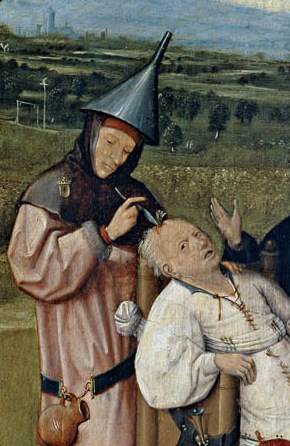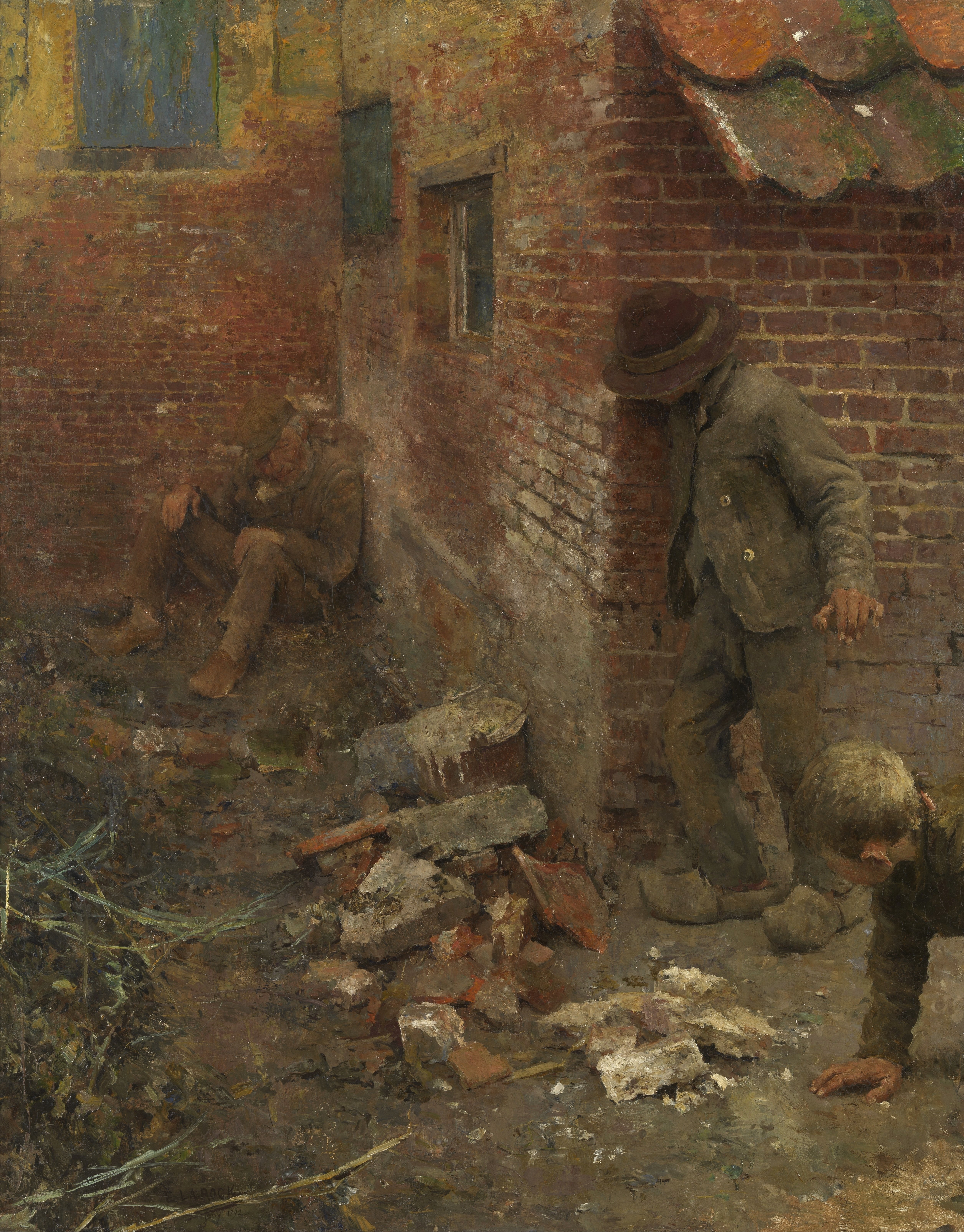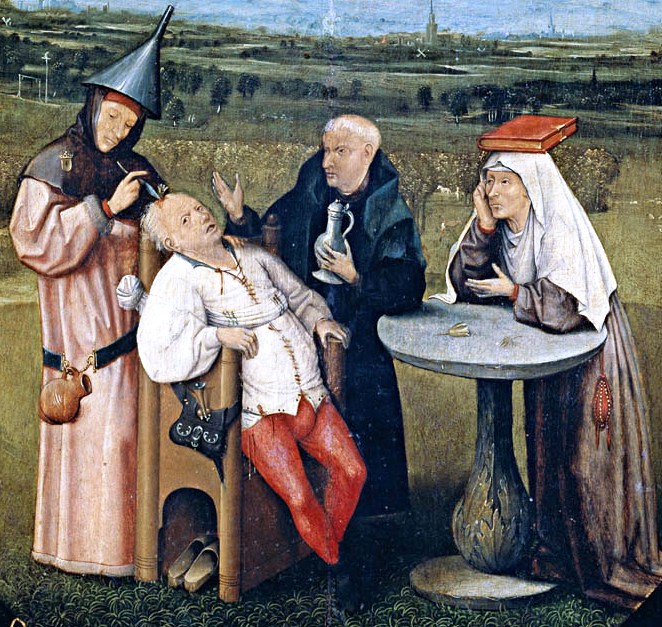|
Stone Of Madness
The stone of madness, also called stone of folly, was a hypothetical stone in a patient's head, thought to be the cause of madness, idiocy or dementia. From the 15th century onwards, removing the stone by trepanation was proposed as a remedy. This procedure is demonstrated in the painting '' The Extraction of the Stone of Madness'' by Hieronymus Bosch. Gallery File:Quentin Massys 030.jpg, Quentin Massys, ''An Allegory of Folly'' (early 16th century). The fool has a "stone of folly" in his forehead. File:Pieter Huys A surgeon extracting the stone of folly.jpg, Pieter Huys, ''A surgeon extracting the stone of folly'' File:Hemessen-cirujano-prado.jpg, Jan Sanders van Hemessen Jan Sanders van Hemessen (c. 1500 – c. 1566) was a leading Flemish Renaissance painter, belonging to the group of Italianizing Flemish painters called the Romanists, who were influenced by Italian Renaissance painting. Van Hemessen had v ..., 1550s File:Het_snijden_van_de_kei._Rijksmuseum_SK-A-1601.j ... [...More Info...] [...Related Items...] OR: [Wikipedia] [Google] [Baidu] |
Hieronymus Bosch-Removing The Rocks From The Head-Detail
Hieronymus, in English pronounced or , is the Latin form of the Ancient Greek name (Hierṓnymos), meaning "with a sacred name". It corresponds to the English given name Jerome. Variants * Albanian: Jeronimi * Arabic: جيروم (Jerome) * Basque: Jeronimo * Belarusian: Еранім (Yeranim) * Bulgarian: Йероним (Yeronim) * Catalan: Jeroni * Written Chinese: 希罗尼穆斯 ** Chinese Pinyin: xī luó ní mù sī * Croatian: Jeronim * Czech: Jeroným, Jeronýmus (archaic) * Danish: Hieronymus * Dutch: Hiëronymus, Jeroen * English: Jerome, Hieronymus, Geromy, Rhonemus * Esperanto: Hieronimo * Estonian: Hieronymus * Finnish: Hieronymus * Flemish: Jerom * French: Jérôme, Gérôme * Galician Xerome * German: Hieronymus * Ancient Greek : (Hierṓnymos) * Modern Greek: Ιερώνυμος (Ierónymos) * Hebrew: הירונימוס (Hieronymus) * Hungarian: Jeromos * Indonesian: Hieronimus * Interlingua: Jeronimo * Italian: Girolamo, Gerolamo, Geronimo, Geromino * Japa ... [...More Info...] [...Related Items...] OR: [Wikipedia] [Google] [Baidu] |
Idiocy
An idiot, in modern use, is a stupid or foolish person. 'Idiot' was formerly a technical term in legal and psychiatric contexts for some kinds of profound intellectual disability where the mental age is two years or less, and the person cannot guard themself against common physical dangers. The term was gradually replaced by 'profound mental retardation', which has since been replaced by other terms. Along with terms like moron, imbecile, retard and cretin, its use to describe people with mental disabilities is considered archaic and offensive. Moral idiocy refers to a moral disability. Etymology The word "idiot" comes from the Greek noun ''idiōtēs'' 'a private person, individual' (as opposed to the state), 'a private citizen' (as opposed to someone with a political office), 'a common man', 'a person lacking professional skill, layman', later 'unskilled', 'ignorant', derived from the adjective ''idios'' 'personal' (not public, not shared).Liddell-Scott-Jones ''A Greek– ... [...More Info...] [...Related Items...] OR: [Wikipedia] [Google] [Baidu] |
Dementia
Dementia is a disorder which manifests as a set of related symptoms, which usually surfaces when the brain is damaged by injury or disease. The symptoms involve progressive impairments in memory, thinking, and behavior, which negatively affects a person's ability to function and carry out everyday activities. Aside from memory impairment and a disruption in thought patterns, the most common symptoms include emotional problems, difficulties with language, and decreased motivation. The symptoms may be described as occurring in a continuum over several stages. Consciousness is not affected. Dementia ultimately has a significant effect on the individual, caregivers, and on social relationships in general. A diagnosis of dementia requires the observation of a change from a person's usual mental functioning, and a greater cognitive decline than what is caused by normal aging. Several diseases and injuries to the brain, such as a stroke, can give rise to dementia. However, th ... [...More Info...] [...Related Items...] OR: [Wikipedia] [Google] [Baidu] |
Trepanation
Trepanning, also known as trepanation, trephination, trephining or making a burr hole (the verb ''trepan'' derives from Old French from Medieval Latin from Greek , literally "borer, auger"), is a surgical intervention in which a hole is drilled or scraped into the human skull. The intentional perforation of the cranium exposes the ''dura mater'' to treat health problems related to intracranial diseases or release pressured blood buildup from an injury. It may also refer to any "burr" hole created through other body surfaces, including nail beds. A trephine is an instrument used for cutting out a round piece of skull bone to relieve pressure beneath a surface. In ancient times, holes were drilled into a person who was behaving in what was considered an abnormal way to let out what people believed were evil spirits. Evidence of trepanation has been found in prehistoric human remains from Neolithic times onward. The bone that was trepanned was kept by the prehistoric people and m ... [...More Info...] [...Related Items...] OR: [Wikipedia] [Google] [Baidu] |
Cutting The Stone
__NOTOC__ ''Cutting the Stone'', also called ''The Extraction of the Stone of Madness'' or ''The Cure of Folly'', is a painting by Hieronymus Bosch, displayed in the Museo del Prado in Madrid, completed around 1494 or later. The painting depicts a surgeon, wearing a funnel hat, removing the stone of madness from a patient's head by trepanation. An assistant, a monk bearing a tankard, stands nearby. Playing on the double-meaning of the word (stone or bulb), the stone appears as a flower bulb, while another flower rests on the table. A woman with a book balanced on her head looks on. The inscription in gold-coloured Gothic script reads: ''Lubbert Das'' was a comical (foolish) character in Dutch literature. Interpretations It is possible that the flower hints that the doctor is a charlatan as does the funnel hat. The woman balancing a book on her head is thought by Skemer to be a satire of the Flemish custom of wearing amulets made out of books and scripture, a pictogram for ... [...More Info...] [...Related Items...] OR: [Wikipedia] [Google] [Baidu] |
Hieronymus Bosch
Hieronymus Bosch (, ; born Jheronimus van Aken ; – 9 August 1516) was a Dutch/Netherlandish painter from Brabant. He is one of the most notable representatives of the Early Netherlandish painting school. His work, generally oil on oak wood, mainly contains fantastic illustrations of religious concepts and narratives. Within his lifetime his work was collected in the Netherlands, Austria, and Spain, and widely copied, especially his macabre and nightmarish depictions of hell. Little is known of Bosch's life, though there are some records. He spent most of it in the town of 's-Hertogenbosch, where he was born in his grandfather's house. The roots of his forefathers are in Nijmegen and Aachen (which is visible in his surname: Van Aken). His pessimistic fantastical style cast a wide influence on northern art of the 16th century, with Pieter Bruegel the Elder being his best-known follower. Today, Bosch is seen as a hugely individualistic painter with deep insight into ... [...More Info...] [...Related Items...] OR: [Wikipedia] [Google] [Baidu] |
The Economist
''The Economist'' is a British weekly newspaper printed in demitab format and published digitally. It focuses on current affairs, international business, politics, technology, and culture. Based in London, the newspaper is owned by The Economist Group, with its core editorial offices in the United States, as well as across major cities in continental Europe, Asia, and the Middle East. In 2019, its average global print circulation was over 909,476; this, combined with its digital presence, runs to over 1.6 million. Across its social media platforms, it reaches an audience of 35 million, as of 2016. The newspaper has a prominent focus on data journalism and interpretive analysis over original reporting, to both criticism and acclaim. Founded in 1843, ''The Economist'' was first circulated by Scottish economist James Wilson to muster support for abolishing the British Corn Laws (1815–1846), a system of import tariffs. Over time, the newspaper's coverage expanded further into ... [...More Info...] [...Related Items...] OR: [Wikipedia] [Google] [Baidu] |
Quentin Massys
Quentin Matsys ( nl, Quinten Matsijs) (1466–1530) was a Flemish painter in the Early Netherlandish tradition. He was born in Leuven. There is a tradition alleging that he was trained as an ironsmith before becoming a painter. Matsys was active in Antwerp for over 20 years, creating numerous works with religious roots and satirical tendencies. He is regarded as the founder of the Antwerp school of painting, which became the leading school of painting in Flanders in the 16th century. He introduced new techniques and motifs as well as moralising subjects without completely breaking with the tradition.Nanny Schrijvers, ''Quinten Massijs '' at Flemish Primitives Early life Most early accounts of Matsys' life are composed primarily of legend and very little co ...[...More Info...] [...Related Items...] OR: [Wikipedia] [Google] [Baidu] |
Fool (stock Character)
There are several distinct, although overlapping categories of fool as a stock character in creative works (literature, film, etc.) and folklore: simpleton fool, clever fool, and serendipitous fool. Silly fool A silly, stupid, simpleton, luckless fool is a butt of numerous jokes and tales all over the world. Sometimes the foolishness is ascribed to a whole place, as exemplified by the Wise Men of Gotham. The localizing of fools is common to most countries, and there are many other reputed imbecile centres in England besides Gotham. Thus there are the people of Coggeshall, Essex, the "carles" of Austwick, Yorkshire, the "gowks" of Gordon, Berwickshire, and for many centuries the charge of folly has been made against silly Suffolk and Norfolk (''Descriptio Norfolciensium'' about twelfth century, printed in Wright's ''Early Mysteries and other Latin Poems''). In Germany there are the " Schildbürger", from the fictitious town of "Schilda"; in the Netherlands, the people of K ... [...More Info...] [...Related Items...] OR: [Wikipedia] [Google] [Baidu] |
Pieter Huys
Pieter Huys (c.1519 – c.1584) was a Flemish Renaissance painter. He is known of his early life, and though he was mostly active in Antwerp, his place of birth and death is not certain. He became a master in the Antwerp Guild of St. Luke in 1545, and his last dated work is from 1577. He is known as a follower of Jheronimus Bosch.Pieter Huys in the RKD
The Netherlands Institute for Art History or RKD (Dutch: RKD-Nederlands Instituut voor Kunstgeschiedenis), previously Rijksbureau voor Kunsthistorische Documentatie (RKD), is located in The Hague and is home to the largest art history center i ...
[...More Info...] [...Related Items...] OR: [Wikipedia] [Google] [Baidu] |
Jan Sanders Van Hemessen
Jan Sanders van Hemessen (c. 1500 – c. 1566) was a leading Flemish Renaissance painter, belonging to the group of Italianizing Flemish painters called the Romanists, who were influenced by Italian Renaissance painting. Van Hemessen had visited Italy during the 1520s, and also Fontainebleau near Paris in the mid 1530s, where he was able to view the work of the colony of Italian artists known as the First School of Fontainebleau, who were working on the decorations for the Palace of Fontainebleau.Burr Wallen. "Hemessen." Grove Art Online. Oxford Art Online. Oxford University Press. Web. 20 December 2016 Van Hemessen's works show his ability to interpret the Italian models into a new Flemish visual vocabulary.Jan Sanders van Hemessen, ''Christ as Tri ... [...More Info...] [...Related Items...] OR: [Wikipedia] [Google] [Baidu] |
Pieter Quast
Pieter Jansz. Quast (1605 or '06 – buried 29 May 1647) was a Dutch Golden Age painter and draughtsman, mostly producing small social genre paintings, ranging from elegant merry companies to guardroom scenes and (most numerous) groups of peasants, in a variety of styles which can be related to those of leading artists in these genres, but with personal aspects in the colouring and style. They "are heavily and powerfully rendered in warm shades of brown, set off by strong local colouring in the principal figures. His successful peasant scenes are characterized by the use of strong chiaroscuro and a gentle, harmonious palette. The caricatural quality of Quast’s peasants recalls the work of his fellow-resident of The Hague, Adriaen van de Venne, but Quast’s looser style and many of his individual types are closer to the paintings of Adriaen Brouwer, as well as of Adriaen van Ostade, to whom Quast’s best work has sometimes been ascribed".Leistra He also produced finishe ... [...More Info...] [...Related Items...] OR: [Wikipedia] [Google] [Baidu] |









